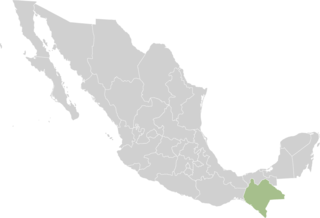 W
WThe 1999 Oaxaca earthquake occurred on September 30 at 11:31 local time in Oaxaca, Mexico, 60 km NNW of Puerto Ángel. The epicenter was located near San Agustin Loxicha. It had a magnitude of Mw 7.4. The maximum intensity reached MM VIII in southwestern Oaxaca, and could be felt strongly in Mexico City. The torrential rains preceding and following the temblor intensified the damage of this earthquake. Thirty-five people were reported dead. The archeological site of the ancient Zapotec city of Monte Alban also suffered damage in this earthquake. This was an intraplate earthquake in the Cocos Plate, with a normal-faulting mechanism. The fault plane was 90 km long and 45 km wide. The maximum slip was about 2.5 m, which was located about 20 and 40 km WNW of the hypocenter.
 W
WThe Chiapas conflict refers to the 1994 Zapatista uprising, the 1995 Zapatista crisis and their aftermath, and tensions between the indigenous peoples and subsistence farmers in the Mexican state of Chiapas from the 1990s to the present day.
 W
WGeneración de la Ruptura is the name given by art critic Teresa del Conde to the generation of Mexican artists against the established Mexican School of Painting, more commonly called Mexican muralism post World War II. It began with the criticisms of José Luis Cuevas in the early 1950s, followed by others who thought the established art had become dogmatic, formulaic and nationalistic and the artists too deferential to the government. This new generation of artists was not bound by a particular artistic style but was more interested in personal rather than social issues and influenced by a number of international trends in art such as Abstract expressionism. Early reaction to them was strong and negative but by the end of the 1950s, they had succeeded in having their art shown in the major venues of Mexico. The Generación de la Ruptura had influence on other arts in Mexico, such as literature but it did not end the production of murals in Mexico with social and nationalist purposes.
 W
WThe Institutional Revolutionary Party is a Mexican political party founded in 1929 that held uninterrupted power in the country for 71 years from 1929 to 2000, first as the National Revolutionary Party, then as the Party of the Mexican Revolution and finally as the PRI beginning in 1946.
 W
WThe Maximato was a transitional period in the historical and political development of Mexico from 1928 to 1934. Named after former president Plutarco Elías Calles's sobriquet el Jefe Máximo, the Maximato was the period that Calles continued to exercise power and exert influence without holding the presidency. The six-year period was the term that President-elect Alvaro Obregón would have served if he had not been assassinated immediately after the July 1928 elections. There needed to be some kind of political solution to the presidential succession crisis. Calles could not hold the presidency again because of restrictions on re-election without an interval out of power, but he remained the dominant figure in Mexico.
 W
WMexican muralism was the promotion of mural painting starting in the 1920s, generally with social and political messages as part of efforts to reunify the country under the post-Mexican Revolution government. It was headed by "the big three" painters, Diego Rivera, José Clemente Orozco and David Alfaro Siqueiros. From the 1920s to about 1970s many murals with nationalistic, social and political messages were created on public buildings, starting a tradition which continues to this day in Mexico and has had impact in other parts of the Americas, including the United States, where it served as inspiration for the Chicano art movement.
 W
WThe Mexican Revolution was a major revolution, including a sequence of armed struggles, lasting roughly from 1910 to 1920, that transformed Mexican culture and government. Its outbreak in 1910 resulted from the increasing unpopularity of the 31-year-long regime of Porfirio Díaz and the regime's failure to find a controlled solution to presidential succession. This resulted in a power struggle among competing elites, which created the opportunity for agrarian insurrection. Wealthy landowner Francisco I. Madero challenged Díaz in the 1910 presidential election, and following the rigged results, revolted under the Plan of San Luis Potosí.
 W
WThe Senate of the Republic, constitutionally Chamber of Senators of the Honorable Congress of the Union, is the upper house of Mexico's bicameral Congress. It currently consists of 128 members, who serve six-year terms.
 W
WThe Supreme Court of Justice of the Nation (Spanish: Suprema Corte de Justicia de la Nación is the Mexican institution serving as the country's federal high court and the spearhead organisation for the judiciary of the Mexican Federal Government. It consists of eleven magistrates, known as ministers of the court, one of whom is designated the court's president.
 W
WThe Torre Latinoamericana is a skyscraper in downtown Mexico City, situated in the historic city center. Its central location, height, and history make it one of the city's most important landmarks. It is widely recognized internationally as an engineering and architectural landmark since it was the world's first major skyscraper successfully built on highly active seismic zone. The skyscraper notably withstood the 8.1 magnitude 1985 Mexico City earthquake without damage, whereas several other structures in the downtown area were damaged.